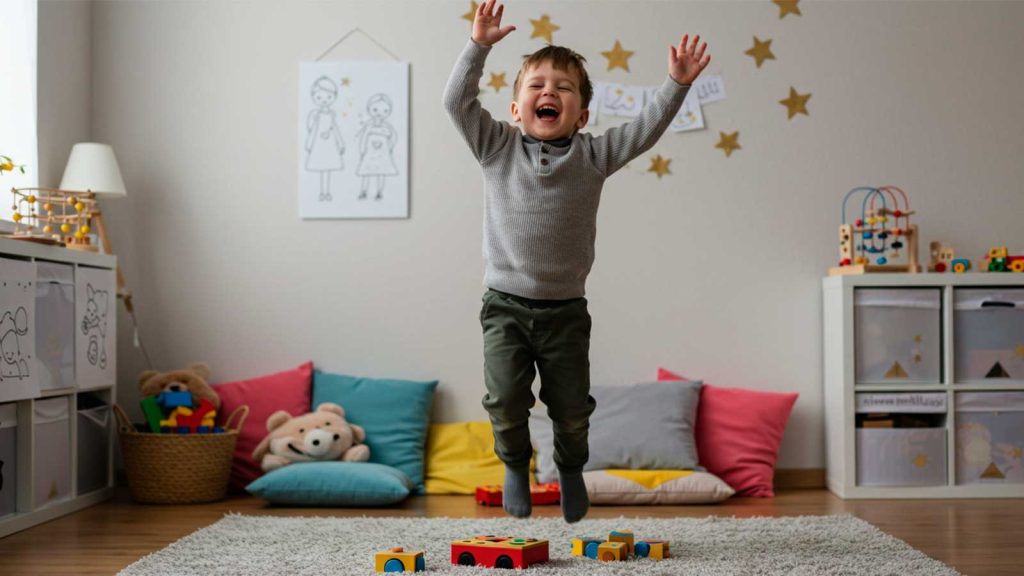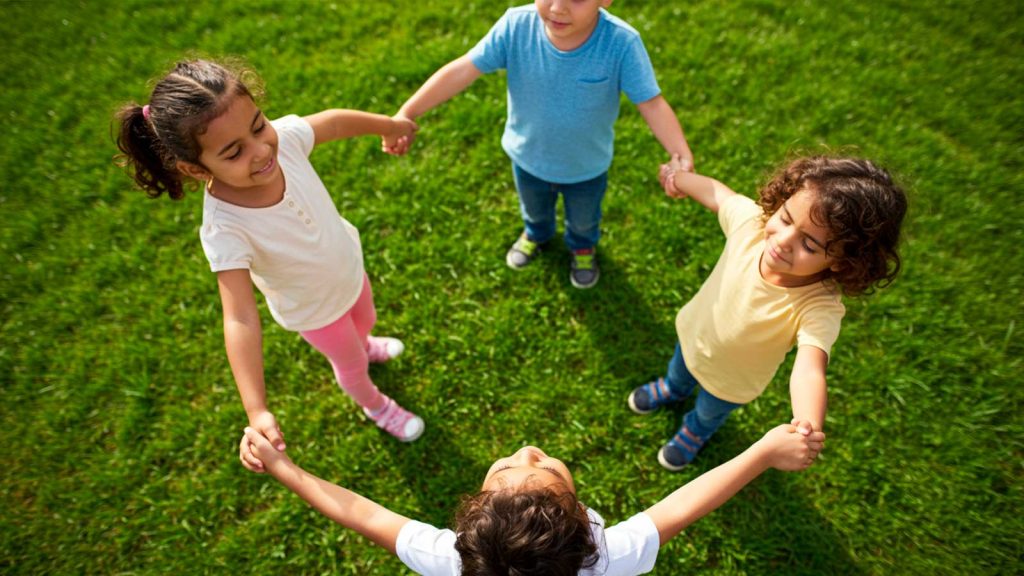Children have a pure heart and a special sensitivity for learning spiritual things. Therefore, prayer for children is a valuable path to help them grow with positive values, confidence, and love. In this article, we will explore how to teach simple prayers, which models are most suitable, and how to integrate these moments into the family’s daily life.
Let’s dive into this essential topic, understand its nuances, and discover practical ways to apply prayer for children in everyday routines.
Prayer Models for Children
Prayer for Children Before Bed
“Heavenly Father, thank You for this day. Protect my sleep and take care of my family. Amen.”
This short, easy prayer for children is perfect for nighttime, helping to bring peace before sleep.
Prayer of Gratitude for Children
“Lord, thank You for everything I have: my family, my friends, my home, and my health. Amen.”
Here, the emphasis is on teaching the child to be thankful for the small things.
Prayer for Children in Difficult Moments
“God, I am afraid. Help me be courageous and remind me that You are with me. Amen.”
This prayer for children is important for times of fear, anxiety, or challenges, showing that they can trust and ask for help.
Bible Coloring Pages to Print – Free
Bible coloring pages are an excellent way to introduce children and adults to the inspiring stories and teachings of the Bible.
Besides being a playful activity, coloring is a creative way to reinforce biblical knowledge, stimulating memory and reflection on important passages of Scripture.
In this article, we will explore the benefits of coloring biblical drawings, suggest popular themes for this activity, and give tips to make the most of this experience. You can also download a free eBook with 25 Bible images to color!

Examples of Children’s Prayers by Theme
Prayer for Children for Protection
“Dear God, protect me at school today, take care of me and my friends. Amen.”
Prayer for Children for Dad and Mom
“Lord, bless my dad and my mom, give them health and joy. Amen.”
Prayer for Children for Nature
“Thank You, God, for the animals, the flowers, and the sky. Help me take care of the planet. Amen.”
Why Is Prayer for Children Important?
Teaching prayer for children goes far beyond repeated words. It offers them a moment of connection, reflection, and gratitude. This habit helps to:
- Develop a sense of gratitude
- Help deal with fears and insecurities
- Establish moments of peace and inner silence
- Strengthen family bonds during group prayers
- Teach values such as kindness, forgiveness, and respect
When parents or guardians take time to say a prayer for children, they are planting seeds of love and trust in the little ones’ hearts.
How to Teach Prayer to Children
Use Simple and Loving Language
Children learn through example and affection. When teaching a prayer for children, use simple words, short sentences, and a warm tone. You can start by saying, “Now let’s talk to God,” or “Let’s thank Him for our day.”
Explain the Meaning of the Words
Repetition is not enough. Explain what each part of the prayer for children means. For example, if the prayer says “Thank You for our daily bread,” explain that it is a way to recognize everything we receive every day.
Set Aside a Special Moment in the Day
The most common time for prayer for children is before bedtime, but it can also be upon waking up or before meals. The important thing is to create a routine that the child associates with that moment.
How to Make Prayer a Habit for Children
Include the Whole Family
When the entire family participates, the child feels that prayer for children is not just for them but part of a shared routine. This sets an example and strengthens bonds.
Use Songs and Music
Many children learn better through music. A sung prayer for children can be more fun and easier to remember. There are many children’s songs with prayer messages.
Create a Prayer Corner
Set up a special space at home with cushions, a children’s Bible, or images that inspire the child. This place will be associated with quiet, special moments of prayer for children.

Emotional and Behavioral Benefits
Prayer for children is not only a religious act but also a practice that strengthens emotional aspects. Children who pray regularly demonstrate:
- Greater empathy for others
- Better ability to handle frustrations
- Less fear at bedtime
- Greater understanding of moral values
These benefits arise because prayer for children helps them process feelings and feel welcomed even in difficult times.

How to Adapt Prayer for Children of Different Ages
Young Children (Ages 2–5)
Use very short phrases, encourage repetition, and celebrate every participation.
School-Age Children (Ages 6–9)
Include personal requests in the prayer for children, such as friends, tests, and teachers. Show that God is present in every detail of the day.
Pre-teens (Ages 10–12)
Encourage spontaneous prayers in their own words. Help children understand that there is no “right” way to pray; what matters is sincerity.
How to Handle Doubts and Questions
When we teach prayer for children, it is common for doubts to arise, and these questions are a wonderful sign that the child is reflecting and internalizing what they are learning. Instead of avoiding these questions, adults should welcome them with patience, turning the moment of doubt into an opportunity for dialogue and growth.
Why Doesn’t God Always Answer?
Explain that God always hears but does not always answer the way we want or in the time we expect. A good analogy for prayer for children is to say that God is like a loving father who knows what is best for His children. Sometimes He says “yes,” other times “no,” and sometimes “wait.” This helps the child understand that not everything happens immediately, but they can trust God’s care.
Does God Hear Everyone at the Same Time?
Children often imagine God much like the adults around them, so it’s normal for them to wonder, “How can He hear so many people at once?” A simple explanation for prayer for children is to say that God is much greater and more powerful than anything we know. He can hear everyone at the same time because He is infinite, and His love has room for everyone. This reinforces the trust that their prayer has value and importance.
Do I Need to Close My Eyes to Pray?
Many children think they need to do everything “just right” in prayer for children: hands together, eyes closed, kneeling. Explain that these gestures help us focus but are not mandatory. The most important thing is the heart: you can pray with eyes open, while walking, drawing, or even silently in your thoughts. What matters is sincerity.
How to Respond When a Child Questions God’s Existence?
This is a deep question and, depending on the age, can be unsettling for adults. Stay calm and listen to what the child wants to express. Explain that faith grows over time and that even adults sometimes have doubts. Encourage the child to keep praying even when questioning, because God understands our uncertainties and helps us find answers.
How to Avoid Discouraging Answers?
Sometimes, in an effort to simplify, adults may answer hastily or even scold: “Because that’s how it is!” or “Don’t think about that!” This type of response can make the child withdraw. Instead, say: “That’s a very good question, shall we think about it together?” or “I’ve wondered about that too, did you know?” In this way, you strengthen the bond and keep prayer for children as an open space, not a rigid obligation.

Golden Tips to Motivate Children
- Never force—encourage with love.
- Emphasize that prayer for children is a special moment.
- Use children’s Bible stories to illustrate the importance of prayer.
- Participate actively by praying together with them.
How to Avoid Mistakes When Teaching Prayer to Children
Teaching prayer for children is an act of love, but it can easily become a mechanical habit or even cause rejection if not handled carefully. To ensure this moment is truly meaningful and positive, it’s important to watch out for some common mistakes. Let’s expand on each of them:
Don’t Use Prayer as Punishment
One of the biggest mistakes is turning prayer for children into a tool for correction or punishment by saying things like:
- “You didn’t pray today, and that’s why this happened.”
- “If you don’t pray, God will be angry.”
This approach creates fear instead of love and connection. The child starts to see prayer as a heavy obligation associated with punishment rather than a moment of affection, dialogue, and gratitude. Remember: God is not waiting for perfection; He is always ready to listen. Ideally, reinforce that prayer is a gift and an opportunity, not a rigid obligation.
Don’t Turn Prayer into Something Mechanical
Another common mistake is making prayer for children just an automatic repetition. When children pray only because they “have to,” without understanding or feeling it, the moment loses meaning. How to avoid this?
- Vary the prayers, adapting to what the child experienced that day.
- Let them use their own words, even if simple.
- Show enthusiasm and sincerity when you also pray with them.
Thus, prayer ceases to be just a “task” and becomes a living moment aligned with the child’s heart.
Give Space for Questions and Reflections
Often, in the desire to “do everything right,” adults forget that the child also needs to understand what they are doing. It’s essential to leave room for questions such as:
- “Why do we pray?”
- “Is God listening to me right now?”
- “Can I pray for anything?”
Listening to these questions with patience and responding lovingly strengthens the experience. Moreover, it allows the child to grow in faith genuinely, rather than merely copying behaviors. This makes prayer for children a path of continuous learning, not an empty ritual.
Create a Positive and Pleasant Atmosphere
Avoid making prayer a rushed, irritated, or inattentive moment. For example, if the child is tired or distracted, don’t force them to pray quickly just to “tick the box.” It’s better to save that moment for when everyone can be present calmly, joyfully, and willingly. A positive environment is essential for prayer for children to be associated with good memories, not stress.
Encourage Sincerity, Not Perfection
It’s common for adults to want children to say everything “just right,” but remember: prayer doesn’t have to be perfect. If the child mispronounces words, forgets phrases, or expresses themselves awkwardly, it doesn’t matter. The beauty of prayer for children lies in spontaneity. Encourage them by saying, “What matters is speaking from the heart.”
FAQ on Prayer for Children
What’s the best age to start prayer for children?
The sooner, the better. Even very young children can learn simple gestures, like joining their hands or saying “Amen.”
How many times a day should I pray with a child?
There isn’t a fixed number. It could be before meals, upon waking up, and before bedtime, for example. The important thing is to create a routine.
How can I teach a shy child to pray in public?
Start at home, in intimate moments. Over time, confidence grows, and they will feel more comfortable praying in a group.
What if the child doesn’t want to pray?
Don’t force it. Set an example, share family prayer moments, and respect their timing.
Can I use apps or videos to help?
Yes! There are many digital resources with songs, stories, and children’s prayers that make the moment more engaging.
READ ALSO:
- Psalm 76: Deep Reflections and Meanings
- Psalm 75: Acknowledging Divine Justice and God’s Power
- Psalm 74: Reflections on the Divine Presence in Times of Crisis
FOLLOW US ON FACEBOOK
I hope you enjoyed it.